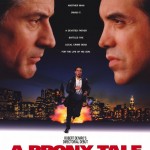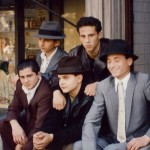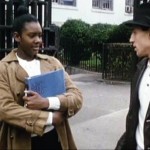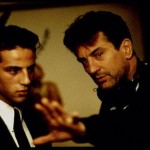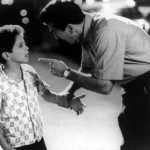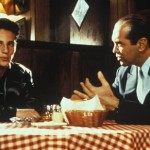A Bronx Tale (1993)
*** Burke Favorite Scene ***
Dir: Robert De Niro
Stars: Robert De Niro, Chazz Palminteri, Lillo Brancato and Joe Pesci
A Bronx Tale is one of the many classic coming of age stories, told within the setting of the famous New York neighborhood and boasting a colorful cast of Italian-Americans. Some of these characters are on the up and up: others of them are less than legitimate. The film also possesses a very appropriate and intruiging poster, which helps advise the theater-goer what the film is about. Take a look: doesn’t it look like these guys are negotiating over the fate of the kid running beneath them?
On the poster, we have “the kid” played by Lillo Brancato (see Note 1), running near the bottom of the foreground. “C”, which is short for Calogoro, loves his Dad, but is tempted and seduced by the respect and fear commanded by the local mafia chieftain. The father figure (on the left of the poster, in close up) is played by DeNiro: he’s the guy trying to teach his son the legitimate way of living your life, even if it is driving a bus for more than 20 years. There’s the neighborhood wiseguy, the chief, the boss, the man (placed on the right of the poster, in close up): in Palminteri, we have a more wealthy, more respected and more feared advisor, who (allegedly) treats the boy as his own son. A Bronx Tale essentially tells the story of the power struggle between these two influences on “the kid” as he grows up. If you haven’t seen it, to the top of your Netflix cue it should go!
However, I’m writing this entry because I wanted to discuss one special scene within the movie, which occurs around the midway point. This scene is crucial to the rest of the story. Sonny, the mafia chief, is answering some very difficult and philosophical questions that C puts to him, such as “is it better to be loved or feared”. Their discussion is interrupted by a cacophony of sound from a biker gang: this being the late 1960s, C has admitted in voice over that while the world had been changing, his neighborhood had remained exactly the same. Sonny gets up to have a look out the bar window at the gang, which is clearly being disrespectful to the neighborhood. In fact, did one of the bikers wave to the Catholic church down the street?
We then have a smash cut to later that day. Sonny is walking back up the street and into his bar, along with C: the cut comes perfectly placed with the opening of The Beatles’ great track, Come Together. It’s only later that we understand the bikers have played this song on the bar’s jukebox. Regardless, the song continues to play throughout the scene, and puts a nice underscore to the entire question of conflict related to why this scene is even in the movie: in other words, which crew – the bikers or the mobsters – will “come together” more effectively? And what’s more, how will this experience effect C?
As Sonny enters the bar, one of his associates, Jimmy Whispers (all of Sonny’s crew have crazy names like this), is explaining to the bikers that they have to leave because they’re not properly dressed. Sonny asks what the problem is, and the lead biker says they just want a couple of beers, no trouble, their money’s green, then they’ll be on their way. Sonny, acting casually and remaining calm, clearly doesn’t believe the guy: but after a pause, he says, “You spoke like a gentleman, give ’em the beers.”
As the barman distributes beers to all the bikers, Sonny and C go outside to continue their discussion. The lead biker proposes a toast “to their host, in the name of the father, the son and the holy ghost” and proceeds to lead the whole gang in spraying the bar and bartender with beer from their bottles. Sonny, still outside, hits the roof. But… he remains totally calm as he comes back in the bar and barks “Hey!” to the leader. Unimpressed, the leader says, “Aw, you again…” But keep looking at Sonny: he’s calm, as if he’s ordering a plate of veal! He says, “That wasn’t very nice. Now, you gotta leave.” The biker leader says, “I’ll tell you when the fuck we leave…”
Sonny, staying as cool as he’s been throughout the scene, heads outside, looks around a little bit, then closes the front door to the bar and locks it. Suddenly, the bikers are very quiet. He kind of tosses up his hands and says, “Now, youse can’t leave.” A very subtle and important piece of action to note within these few seconds is what Sonny does with C. Now, C is this kid he claims to “treat like [his] own son”, right? Does he lead C out by the neck? No! He lightly presses on his chest as if to say, “don’t move”, then locks C in too… Why does he do this? My suspicion is that Sonny really is a good guy at heart: those of you who have seen A Bronx Tale, you may have a different interpretation, but that’s what I think. He wants to really, truly answer C’s question, “is it better to be loved or feared?” Sonny genuinely wants C to see what it’s like to be a gangster. To keep the action going and the tension level high, DeNiro (as director) does not cut to a close up of Sonny saying a line or two to C, or there being any trite wink or something between them. Sonny just gently pushes C on the chest. On a personal note, I have to say that after watching this scene more than a few times, I have no interest in becoming a mobster. I suppose I’m a little late to start anyhow, huh?
Of course, a huge brawl ensues with the mobsters on the winning side. Stands to reason they’d win with the number of guys, guns, bats and sticks they bring with them into the bar. Highlights of the fight include Sonny walking straight up to the leader of the gang and punching him right in the jaw to start the fight. The hugely obese member of the mobsters, Jojo the Whale, hits a biker so hard he skips “Come Together” right off the jukebox. Then there’s a biker ripping the toupee off of the bartender’s head, only to have the bartender’s hand reach over from underneath the bar and grab the toupee several cuts later. There is Sonny, dragging the leader out, screaming at his gang to “drag ’em the fuck outta here!” There’s the mobsters taking bats and sticks to the bikers’ rides. And of course, there’s the one poor biker who attempts to run away before all of the kids in the Bronx catch him and kick the living crap out of him. In the big finale, Sonny grabs the leader by the hair and says, “I’m the one who did this to you: remember me.”
While this is a terribly violent and horrifying scene, I still say it’s essential to the film and not a throwaway clip of “violence for the sake of violence”. It’s kind of the highlight of Sonny treating C like a man. It’s as if he’s asking the kid, “You want to be a gangster? Really? After all I’ve told you?? Fine! Have a peek at this, kid.” I’m sure most of us would agree this is not the optimal way to teach a kid this lesson of staying away from a life of crime: and surely DeNiro’s father character would’ve had a coniption fit if he found out C had been in the bar at the time of the fight. But regardless, Sonny is a consistent character, and he taught C the cost of violence first hand and the best way he knew how.
Note 1: in a most unfortunate update, I see from Lillo Brancato’s imdb.com biography that he is currently serving a 10 year prison sentence for murdering an off duty New York City policeman during an attempted robbery. Talk about a total travesty…

